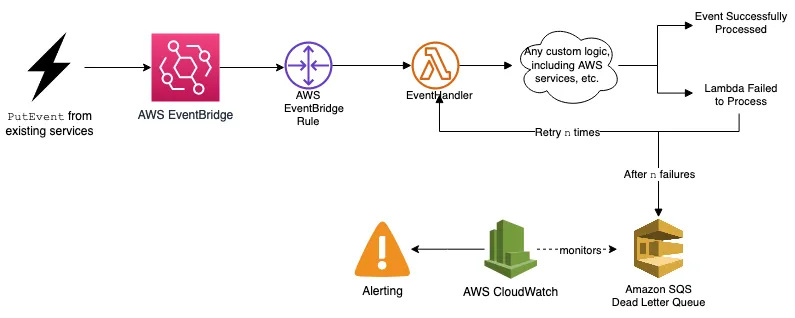Event-Driven Architecture via AWS EventBridge
Event-driven architectures are becoming increasingly popular, especially as more organizations move to loosely coupled architectures (e.g., microservices). ThoughtWorks Decoder has an excellent introduction if you’re unfamiliar with event-driven architecture.
Over the last few years, I’ve successfully deployed serverless event buses via AWS EventBridge to several clients. EventBridge is a highly available, scalable, managed service that integrates cleanly with many essential AWS services. The operational simplicity and scalability make it a great technology to choose for initial deployment and to scale with you in the future.
Starting Point: Single Event to Single Lambda Function
For most clients, I start with a single “paved-road” pattern: a single event type triggers a Lambda function each time it’s posted to the bus.

The flexible PutEvent API allows your existing services to fire events on the event bus.
Once an event is posted to the bus, an EventBridge rule determines the appropriate target for that particular event. The rule syntax is flexible and allows inspecting the event content to determine which Lambda target should be triggered. This flexible rule processing makes implementing one-event-to-one-lambda-target workflows simple and allows for more complex rules in the future.
EventBridge supports the AWS Lambda Asynchronous Invocation API, which provides automatic retry and dead-letter queueing upon repeated failure. Layering this behavior in with CloudWatch alarms and your existing alerting platform (e.g., Datadog or PagerDuty) informs your engineers about problems processing events.
Concrete Example
As a concrete example, imagine you want to notify your users when an unrecognized login occurs. Instead of writing this
logic into your monolith, you could use the PutEvent API to fire an EventBridge event that looks like this:
{ "detail-type": "Customer Notification", "source": "com.benlimmer.Monolith", "resources": ["user@example.com"], "detail": { "notification": "unrecognized-login", "ip-address": "1.2.3.4", "location": "Denver, Colorado, USA" }}Then, an EventBridge rule looking for Customer Notification events triggers a Lambda function with logic to generate
and send the notification to the user.
{ "detail-type": ["Customer Notification"]}The Lambda function will receive the entire event, which provides the details (email address, IP address, location) needed to create the message and send it to the user.
An event-driven system might seem overkill for a single notification, but it’s a great way to start breaking up a monolithic application. It also allows separate teams to own the notifications logic for a system and evolve it as they see fit. They could swap out the templating system, email provider, programming language, etc., and the team working with the monolith wouldn’t know (or care!) about the changes.
Auto-Generated Database Events
In addition to responding to manually triggered events (e.g., via PutEvent), you can accelerate your team’s transition
to an event-driven architecture by auto-generating events. Learn more about how
Serverless Postgres Change Data Capture significantly
accelerated one of my client’s adoption of an event-driven architecture.
More Complex Targets
As mentioned above, AWS EventBridge rules can trigger many services other than AWS Lambda.
A typical workflow I’ve implemented for clients is posting events to a Kinesis Steam to allow batch triggering Lambda functions. Batching requests helps reduce Lambda costs and avoid throttling from third-party services.
You can also trigger AWS Batch, Glue, SageMaker pipelines, and other data analytics-oriented services. These asynchronous data-oriented workflows are often great opportunities to decouple logic from your existing monolithic service.
The possibilities are nearly endless between the natively supported targets and AWS Lambda.
The Paved Road
Developer Experience is hugely important, especially when introducing a new concept, like an Event Bus. That’s why I focus on “paving the road” for your engineers.
By leveraging code generation and Infrastructure-as-Code platforms, usually hygen and
AWS Cloud Development Kit, respectively, working with the Event-Driven Architecture is
delightful. Creating a new event handler is simple:
- Run a code generator.
- Provide details about the event.
- Write the logic and tests for your handler (usually in TypeScript, which I fully support out of the box with zero-config).
- Push the code to your remote source control.
Et voila! The event handler is live. Developers love how easy it is to create and work with existing handlers.
Is AWS EventBridge Right for You?
Even if microservices aren’t an element of your near-term plan, a scalable event bus can provide a simple way to decouple asynchronous tasks from your majestic monolith.
Get in Touch
Interested in working together? Let's connect.
Contact me